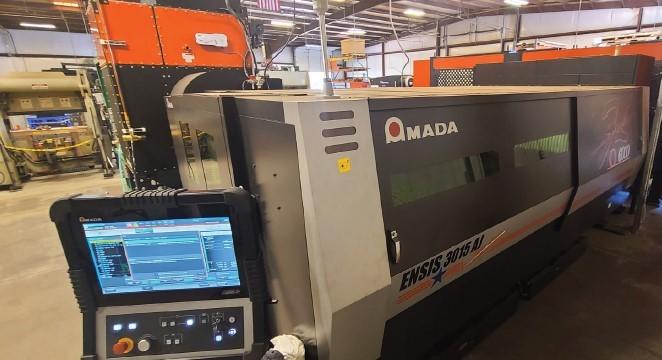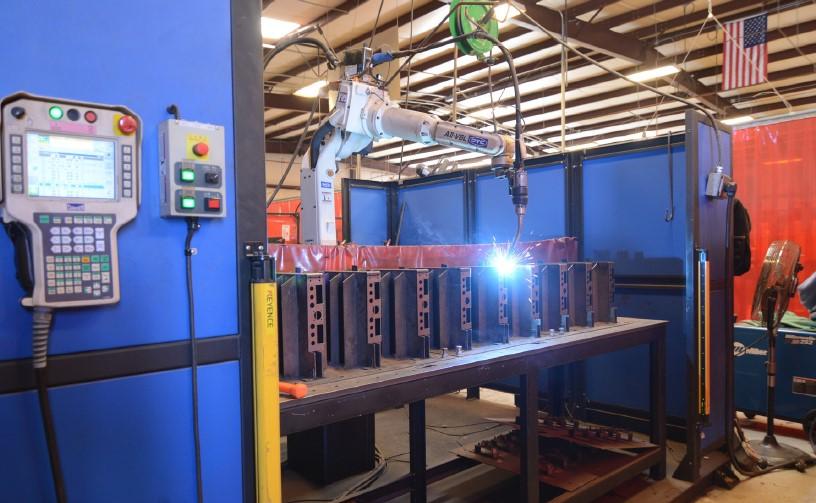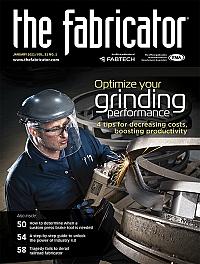Senior Editor
- FMA
- The Fabricator
- FABTECH
- Canadian Metalworking
Categories
- Additive Manufacturing
- Aluminum Welding
- Arc Welding
- Assembly and Joining
- Automation and Robotics
- Bending and Forming
- Consumables
- Cutting and Weld Prep
- Electric Vehicles
- En Español
- Finishing
- Hydroforming
- Laser Cutting
- Laser Welding
- Machining
- Manufacturing Software
- Materials Handling
- Metals/Materials
- Oxyfuel Cutting
- Plasma Cutting
- Power Tools
- Punching and Other Holemaking
- Roll Forming
- Safety
- Sawing
- Shearing
- Shop Management
- Testing and Measuring
- Tube and Pipe Fabrication
- Tube and Pipe Production
- Waterjet Cutting
Industry Directory
Webcasts
Podcasts
FAB 40
Advertise
Subscribe
Account Login
Search
Railroad metal fabricator navigates a tragedy, and thrives
Dallas-area family business endures after death of founder, becomes transformative
- By Tim Heston
- January 27, 2021
- Article
- Shop Management
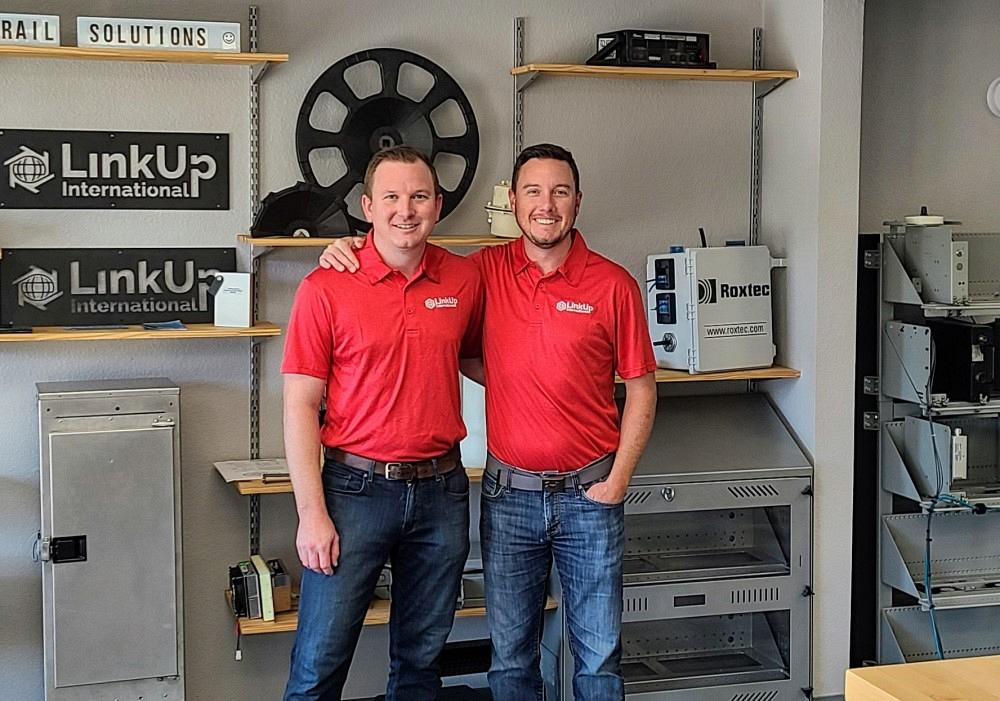
LinkUp Vice President Adam Fritzel (left) focuses on the engineering side of the business, while his brother Nate Fritzel, company president, grew up on the sales side.
Nate Fritzel remembers meeting customers a little more than five years ago to relay somber news: His father, Mike Fritzel, the founder of LinkUp International—fabricator and supplier to the major railroad players—had died. The plant sits adjacent to an airfield northwest of Dallas, from which Mike flew his own small plane, both for pleasure and to visit customers.
In fall 2015 Mike and his wife Paula took off from that airfield and flew to Colorado to celebrate their anniversary. Starting their return trip on Nov. 9, they took off from a Colorado airfield and then ran into trouble shortly thereafter. Authorities never uncovered the exact cause of the crash, but they know that it occurred at low altitude, so it must have happened quickly.
Your dad was my best friend. Nate heard this more than once as he visited customers after the tragedy. Like many company founders, Mike had a magnetic personality. He had built a company that focused on family. Mike’s business relationships weren’t merely transactional. He played golf with customers on the weekend, hosted barbecues and other events for vendors, customers, and anyone else connected to the company. For Mike, it wasn’t just about business, it was about friendship.
Now he was gone. Could the business survive? Very much so, as it turns out, but it’s been a transformative five years. LinkUp is a different place these days. The company carries on Mike’s legacy, but it also has the structure it needs to endure.
The Character of an Entrepreneur
Some fab shop owners and (especially) founders can probably relate to this story: You spend years working for a large corporation. Circumstances change and, fed up with the bureaucracy, you decide to launch a business with as little bureaucracy as possible. Job titles and job descriptions aren’t important. Everyone just works together and, come hell or high water, gets the job done.
That’s Mike Fritzel’s story. For most of his life he made a living as a purchaser of manufactured components at a major railroad company. He was laid off after a merger and in the mid-1990s decided to launch his own business, LinkUp International. His first product was the LinkUp Rail Pail Sanitation system. That’s right, he sold a needed yet underappreciated product: toilets for locomotive cabs and work cars. Made largely of plastic, the toilet remains one of the company’s bestselling products.
LinkUp has always employed engineers, but it didn’t launch as a manufacturing company. At first Mike simply launched LinkUp to solve problems he faced over years in the railroad business as a purchaser. He had been in his customers’ shoes. He knew their challenges and he aimed to ease them.
When LinkUp launched, its engineers designed products (including that toilet) and then contracted out the manufacturing. But by the mid-2000s, an opportunity arose that turned LinkUp into a metal manufacturer: the implementation of positive train control (PTC) across the railroad industry. Among other things, PTC is a backstop to human error. If a train engineer fails to decelerate around a dangerous curve, the PTC—via sensors and GPS—spurs into action and steps on the brakes. PTC requires various electronics that in turn require racking and various sheet metal components to secure them within the locomotive. LinkUp was called upon to provide those components.
With this, the company jumped into the metal manufacturing fray. Mike’s brother-in-law Mark, who managed machining operations at a large plant in Indiana, moved down to Dallas to help with the effort. LinkUp invested in a CO2 laser, press brake, hardware insertion, as well as some lathes and machining centers. Soon after came robotic welding and powder coating.
LinkUp’s fabrication capability evolved around the engineer- and configure-to-order model. Engineers would launch a product, design it for a certain locomotive, but then be able to configure that design to fit other locomotives. The configure-to-order model soon extended to various PTC products, including not only the racking internal to the locomotive, but also the antenna farm mounted on the locomotive’s roof. Over the years the PTC initiative—and its in-house manufacturing efforts overall—pushed LinkUp’s growth from just a handful of employees in 2006 to more than 80 in 2015.
Living out the Legacy
In the months and years before the tragedy in November 2015, LinkUp had several defining characteristics. More than anything else, it was a family company, figuratively and literally. In the literal sense, LinkUp employed a swath of family members. Mike’s two sons worked in the business, Nate on the sales side and his brother Adam on the engineering side. LinkUp’s first employee was Mike’s nephew Jason, who grew into the general manager role and later would become a vice president. One of Mike’s brothers headed the servicing division; another led the accounting department; a brother in-law (the one who moved from Indiana) directed the manufacturing operation; and some of their children worked in admin and a variety of other positions. Every workday was (and still is) a family reunion.
In the figurative sense, a familial culture dominated the place. Nothing was “just business.” When Mike worked with customers, he knew their pains, and he priced with those pains in mind. The company always covered its costs and made a profit, but it didn’t price just according to what the market would bear. And again, like in many family businesses, the founder was the driving force. “My dad was a legend in the rail industry,” Adam recalled.
Nate knew how important Mike’s legacy was. If the company were to continue, the spirit of that familial connection could not die with his father.
So he acted quickly. Five years older than his brother Adam, Nate had grown up on the sales side and was close to both employees and customers, so it just seemed natural for him to take on the president’s role. The company sent letters to customers and communicated with employees. An extensive period of limbo was the last thing the brothers wanted.
As Adam recalled, “The day after the tragedy happened, we really wanted to say to employees, ‘We’re stable. You guys are OK, and your job is OK.’ Nate was really concerned about that, how we came off to employees and customers, because again, my dad was such a legend. We didn’t want to give anyone any time to doubt the output of the company.”
Nate spent the next few months traveling to customers and meeting with them face to face. His message: The company would continue and build off his father’s legacy.
Same Spirit, More Structure
In many ways Mike was the classic American small-business entrepreneur. He thrived in an informal environment where everyone just worked together to get the job done—no need for umpteen memos or emails or endless meetings.
But Nate wasn’t his father. “He would have 30 or 40 lines of communication going on at one time. He worked weekends, golfed with customers. Meanwhile, I’ve got three young kids at home, and I just lost my parents. I knew I couldn’t take all that on.”
Before Mike died, LinkUp effectively had a sales team of two: Nate, who handled roughly 30% of the customer base, and Mike himself, who handled the rest. Almost immediately Nate knew he couldn’t do it all on his own.
“I have really focused on building up a sales team,” he said. “I do oversee the sales team, and I do enjoy the sales aspect of the business, but I wasn’t prepared, and still not prepared, to shoulder all the responsibilities my dad did from a sales and marketing aspect.”
Adam, now vice president, chimed in. “One of the first things we realized is that we had to reorganize the company and build a structure, with different tiers of employees and formal job descriptions. We started continuous improvement and safety committees. We wanted a structure so that the business could run on its own. And we wanted to be so buttoned-up that we’d be ready for anything.”
Company leaders wrote training manuals and procedural documentation, plus instituted drawing revision control. LinkUp had already been certified to AAR/M-1003, a quality system for the railroad supply chain. “We just took that to the next level,” Adam said, “so that everyone knew the procedures, where they were documented, and how everything was supposed to flow through the shop.”
These efforts led to a formal continuous improvement regimen that, among other things, changed how the fabricator controlled its work-in-process (WIP) inventory. By scrutinizing past demand and the configurable nature of each product, the improvement team analyzed different part numbers to determine which and how much could be stored after what process.
Like many fabricators, LinkUp tries to achieve a balance between maximizing material yield in laser cutting and trying to keep just enough in WIP inventory to ensure quick response. The company’s Amada 6-kW fiber laser, installed in early 2020, has control software that aids in nesting to achieve this balance, weighing part geometry (how well it fills a nest for maximum yield) and order history.
Steering the Bicycle
Not long after his father’s death, Nate began getting involved in local business roundtables. During one of those meetings he spoke with another business owner and friend who recommended he work with Rich Allen. A former manufacturing executive at Pella, Allen today owns a business coaching company in the Dallas area called Tour de Profit. The name is, of course, a riff off the Tour de France. Why? Because, according to Allen, companies are like bicycles.
The metaphor avoids all the business management theory and, as Allen put it, “demystifies how the business works so that everyone in the organization can jump onboard, get involved, help find solutions, and make the business better.”
Allen started describing the metaphor where the rubber hits the road: the bicycle’s two wheels. The front wheel represents a company’s ability to win customers and the back wheel represents the ability to serve those customers. For a smooth ride, the wheels need to be well-aligned and in sync.
The brakes help the wheels rotate in a controlled manner. “The brakes are the financial controls, the P&L, the cash flow statement, and your budget,” Allen said. “You need good financial controls in order to know when to put on the brakes on the front or back.”
The bike frame is the org chart, the business structure that shows what each job function is accountable for. And the seat on top is where “people power the bike,” Allen continued. “And you can make adjustment to the seat, including your hiring process, your onboarding process, the compensation plans, how you communicate with people, and your reward structure.”
At last come the handlebars, which represent how a leader steers the business. “When you ride a bike, if any part is broken or out of alignment, it’s not going to be a fun ride,” Allen explained. “In business, we want to have a fun ride and be able to ride really fast.
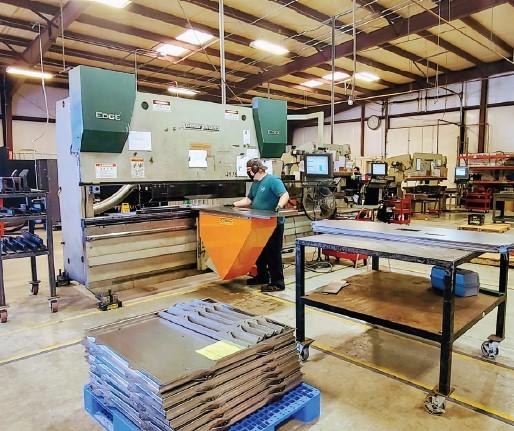
In recent years the company began various continuous improvement initiatives, including 5S and WIP control.
“And here’s another analogy to think about: When we were kids, how did we like to ride our bikes? With our hands in the air. We didn’t have our hands on the handlebars. Too many business owners don’t put their hands on the handlebars and steer their business. It goes wherever it wants to go.”
Today the Fritzels have their hands on the handlebars. In fact, in the coming years they plan to steer the bike onto what they hope to be a much smoother path. “One of the things they did that has worked out so well,” Allen said, “is that they built an organizational structure not for the business of today, but for the business they want to have in three years.”
Identifying the Sweet Spot
It’s not unusual for a product line manufacturer to take on job shop work, and LinkUp is no exception. Low-volume job shop work has been particularly beneficial in 2020, when the quick-turn orders helped filled the revenue shortfalls from its core product lines. “We were actually on track to beat [2019] revenue during the first three months of 2020, but then, of course, we experienced a significant slope downward,” Nate said. “Still, that gave us time to look into how we could get into new markets.”
For its entire history LinkUp’s success has been linked (so to speak) to the rail industry. And in recent years its structure—the front wheel (sales), back wheel (manufacturing and operations), and frame (org chart)—has been tuned to meet the rail business’s needs: product design, engineering, manufacturing, servicing, field work, and distribution.
Much of that work is configure-to-order; that is, the company develops a product for one locomotive or one customer, but then can quickly reconfigure that product for other customers. For instance, LinkUp offers a refrigerator for use in a locomotive cab. The fundamental concept applies to any locomotive, but certain dimensions and mounting bracketry must be configured to suit each application. Such flexibility has helped the company compete among much larger players in the industry.
In recent months the brothers, along with others on the LinkUp leadership team, have been meeting with Allen to develop a strategic plan—where they’d like to steer the bicycle. In 2019 revenue reached $17 million. Except for a decline in 2020, revenue has grown every year since 2016, and the brothers said they are expecting growth again in 2021. “Our goal is to become a $50 million company,” Nate said.
“We just had a strategic planning session,” Allen said, “and rail is still going to be dominant, but they’re also going after other strategic industries. They used to call it ‘rail’ and ‘nonrail.’ Now they’re calling it ‘rail’ and ‘strategic manufacturing’”—that is, the ability to build systems and unique projects for industries and niches with demand that fits LinkUp’s core competencies. (For competitive reasons, of course, Allen and others didn’t reveal what those niches are.) The company’s metaphorical bike is already set up to ride on such a road, so navigating onto it should make for some easy pedaling.
What a Happy Employee Looks Like
In 2015 Nate felt uncomfortable speaking in front of a crowd. He had worked with his dad, of course, and there had been brief conversations about potential succession plans. But when everything changed in November of that year, Nate knew he needed to learn a lot in a hurry, hence his participation in local business groups and his work with Allen.
“Rich really helped build my leadership skills,” Nate recalled. “We talked a lot about how to present, how to stand up and talk in front of 100 employees. I had never done that before. I’ve gone from someone who was scared of speaking in public to someone who actually enjoys it.”
Nate also learned a lot about hiring and employee performance. “I learned what to look for as far as character and work ethic. And I was taught how to know what a happy employee looks like: one who is seen, is heard, and feels appreciated and valued.”
Extending the bicycle metaphor, a happy employee sits on the comfortable seat, finds the pedaling easy, and—neither afraid of uncertainty nor bored with monotony—feels excited about what he sees on the road ahead.
About the Author

Tim Heston
2135 Point Blvd
Elgin, IL 60123
815-381-1314
Tim Heston, The Fabricator's senior editor, has covered the metal fabrication industry since 1998, starting his career at the American Welding Society's Welding Journal. Since then he has covered the full range of metal fabrication processes, from stamping, bending, and cutting to grinding and polishing. He joined The Fabricator's staff in October 2007.
Related Companies
subscribe now

The Fabricator is North America's leading magazine for the metal forming and fabricating industry. The magazine delivers the news, technical articles, and case histories that enable fabricators to do their jobs more efficiently. The Fabricator has served the industry since 1970.
start your free subscription- Stay connected from anywhere

Easily access valuable industry resources now with full access to the digital edition of The Fabricator.

Easily access valuable industry resources now with full access to the digital edition of The Welder.

Easily access valuable industry resources now with full access to the digital edition of The Tube and Pipe Journal.
- Podcasting
- Podcast:
- The Fabricator Podcast
- Published:
- 04/30/2024
- Running Time:
- 53:00
Seth Feldman of Iowa-based Wertzbaugher Services joins The Fabricator Podcast to offer his take as a Gen Zer...
- Industry Events
Pipe and Tube Conference
- May 21 - 22, 2024
- Omaha, NE
World-Class Roll Forming Workshop
- June 5 - 6, 2024
- Louisville, KY
Advanced Laser Application Workshop
- June 25 - 27, 2024
- Novi, MI
Precision Press Brake Certificate Course
- July 31 - August 1, 2024
- Elgin,
























